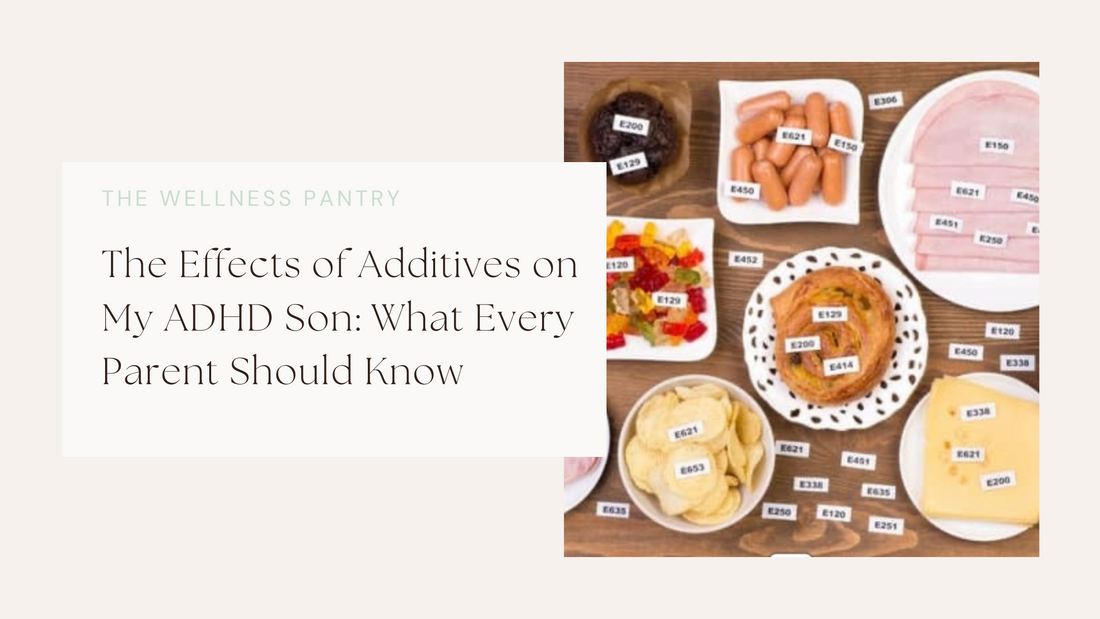
The Effects of Additives on My ADHD Son: What Every Parent Should Know
As a mum of five boys, two of whom has ADHD, I’ve learned the hard way just how much the food we eat affects how we feel and behave. At first, I didn’t think twice about additives—until I started noticing patterns. My son, especially, seemed to have more outbursts and trouble concentrating after certain meals, and I began wondering: was it the food? It turns out, the additives and preservatives in so many of our everyday foods were playing a huge role in his behaviour.
Why Additives and Preservatives Matter
If you’re a mum of a child with ADHD, you know that behaviour can change in the blink of an eye. One minute, everything’s fine, and the next, it feels like the world is falling apart. From hyperactivity to sudden mood swings, it's easy to feel helpless. But after doing some research, I discovered that many of the additives and preservatives in processed foods are linked to exactly those types of behaviours.
These chemicals are often added to food to preserve shelf life, enhance colour, or improve taste. However, they can interfere with our children’s nervous system and trigger hyperactivity, irritability, or even trouble focusing—especially in kids with ADHD. As a mum, that hit me hard. It felt like another piece of the puzzle to help my son, but also another challenge to face.
The Top 5 Additives to Avoid
After digging through ingredients lists and reading up on the latest research, I found there are some common additives and preservatives that seem to be especially problematic for kids with ADHD. So, here’s a list of the top 5 that you might want to watch out for:
1. Artificial Food Colourings (like 102, 110, 129)
These bright colours make food more appealing, but studies have shown that artificial colourings can cause hyperactivity and behavioural issues in children, particularly those with ADHD. My son, for example, would become incredibly wired and restless after eating food with these dyes—think brightly coloured lollies, drinks, jelly, cereals.
2. Sodium Benzoate (211)
This preservative is found in many soft drinks, sauces, and packaged foods. Research suggests that sodium benzoate can cause irritability and restlessness in children with ADHD. It’s often combined with artificial colourings, which makes the effects even worse.
3. Monosodium Glutamate (MSG)
MSG is often used to enhance flavour in foods like soups, crisps, and ready-made meals. For some kids, it can lead to headaches, irritability, and hyperactivity. I remember once when my son ate a packet of crisps containing MSG, and his behaviour took a sharp turn. He became agitated and struggled to sit still, which was a huge red flag for me. We started avoiding MSG, and I saw a real improvement.
4. Sulphites (220-228)
Found in dried fruits, wine, and some processed meats, sulphites are preservatives that can trigger allergic reactions, breathing problems, and, in some cases, worsened ADHD symptoms. Although sulphites are more commonly associated with asthma or skin rashes, they can also affect your child’s mood and behaviour.
5. Annatto (160b)
Annatto is a natural food colouring that comes from the seeds of the achiote tree and is often used to give foods a yellow or orange tint. It’s found in products like cheese, snacks, and some desserts such as icecream (but ot all). While it’s a "natural" colour, annatto can still trigger behavioural issues and allergic reactions in some children, particularly those with ADHD.
How We Made Changes
Making the switch away from foods with these additives wasn’t easy, but it was absolutely worth it. We started by cutting out as many processed foods as possible and focusing on fresh, whole meals. I swapped out snacks with artificial colourings and preservatives for homemade options. We also became label readers—constantly checking for hidden additives and preservatives in the things we bought.
Was it a struggle? Yes. My son didn’t always understand why he couldn’t have certain snacks anymore, but after a few weeks, I began to see a big difference. He was calmer, his focus improved, and most importantly, he seemed happier. There weren’t as many big meltdowns, and his mood was more stable overall.
A Mum’s Journey: A Little Effort for Big Results
As a mum of a child with ADHD, it often feels like you’re juggling a hundred things at once. And adding another "dietary change" to the list can feel overwhelming. But seeing how much of a difference these small changes made in my son’s behaviour was beyond worth it. It’s not always about perfection—it’s about progress. If you’re a mum dealing with ADHD and wondering why your child is struggling, I highly recommend taking a closer look at the food they’re eating. You might just find that the answer is simpler than you think.
In the end, the smallest changes can make the biggest difference. Reducing the artificial colours, preservatives, and additives in your child’s diet might just help bring a little more peace to your home. And every little bit helps, right?
You’re not alone in this. I see you.